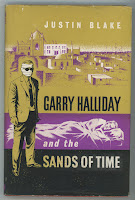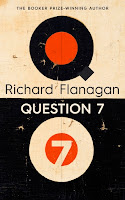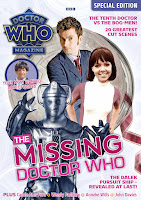It's a short, quirky collection, comprising the following:
pp. 7-12 "Nightmare for Future Reference" (1938) by American poet Stephen Vincent Benét (1898-1943), from the Selected Works of Stephen Vincent Benét
- Some time in the future, the unknown narrator addresses an 18 year-old who was one of the last to be born before, during the Third World War, the birth rate collapsed.
- Written sometime after 1998 (p. 35), an account of the years 1960-85 and the way intelligent dolphins helped end the nuclear stalemate (for more on which, see below).
- During the Third World War, a virus kills American children and the country surrenders to Russia, whereupon Szilard, Henry L Stimson, President Truman and James F Byrnes are put on trial for their roles in the Manhattan Project.
- In 1960, the narrator is put in suspended animation and woken in 2050, where no one has teeth and women choose to impregnate themselves with the seed of a small number of celebrities. The narrator is now such a celebrity.
- A radio message from the planet Cybernetica warns of odd readings detected in the atmosphere of the planet Earth, from which the cybernetic people deduce biological inhabitants, evolution and nuclear war - and warn others to be wary.
- A report by aliens on their exploration of the extinct planet Earth, and their deductions about the life forms that once lived here based on aspects of Grand Central Station, such as the coin-operated toilets.
- The author relates two meals with four year-old Kathy and her mother at a hotel, and the child's conversations with a bear skin hanging there.
- A conversation between "A" and "B" in 1980, looking back on a convoluted system to avoid nuclear annihilation by having Americans mine a Russia city and be ready to blow it up (and themselves), and vice versa.
"the dolphins, who grasped mathematics, chemistry, physics and biology with ease, found it difficult to comprehend America's social and political system" (p. 35)
"The first major investment made by the Vienna Institute was the purchase of television stations in a number of cities all over the world. Thereafter, the television programs of these stations carried no advertising. Since they no longer had to aim their programs at the largest possible audience, there was no longer any need for them to cater to the taste of morons." (p. 18)
"After his death, Szilard appears to have received some recognition, however, from his Russian colleagues, who names a small crater after him - on the back side of the moon." (p. 28)
"It would not affect children at all and would kill predominately men between twenty and forty. Owing to the premature outbreak of the war, however, the Russian government found itself forced to use the stocks which it had on hand." (pp. 69-70)
This is grim humour from a man so closely associated with the development of nuclear weapons he then failed to contain, and well understood the bureaucracy involved in unleashing weapons of mass destruction. There's a similar caustic wit as he considers the option of a new life in Russia, having already lived in Hungary, Germany, England and the US.
"When you are above fifty you are no longer as quick at learning languages. How many years would it take me to get a sufficient command of Russian to be able to turn a phrase and to be slightly malicious without being outright offensive?" (p. 71)
The twist at the end of the tale is that Szilard and his fellows escape the inevitable guilty verdict when the Russians fall victim to their own virus. That's a consistent idea in this book. These weapons are not something we use on other people; whoever unleashes them, we all lose.
The last story, set in 1980, was first published in The Bulletin of the American Scientists in 1961, and includes "B" asking "A" who first thought up the convoluted idea of "mined cities".
"B: Szilard had proposed it in an article published in The Bulletin of the American Scientists in 1961, but the idea may not have been original with him. His proposal was presented in the form of fiction and it was not taken seriously." (p. 120)
The argument then follows, and repeats almost word for word, some of what was covered in "The Voice of the Dolphins" - which Szilard then acknowledges, but says is a complete coincidence.
"A: I read The Voice of the Dolphins when I was ill in the hospital; I remember that it contained many rather crazy prediction, but what they were, I do not recall." (p. 126)
It's a daft book full of complicated, intricate ways to prevent nuclear annihilation - none of them madder than the real predicament facing the world. I've read and heard a lot about Szilard and his rather odd perspective and humour - he was, says Richard Flanagan, one of the Hungarian scientists known as "the Martians" because they were so odd.
The blurb for this book refers to his "wry sense of humour and a heartfelt fear for the future of mankind". More than anything, there's a playfulness here, following any daft idea to its logical end. But what did Einstein, or President Truman, make of this strange fellow and his extended flights of fancy. I suspect he was exhausting.


























